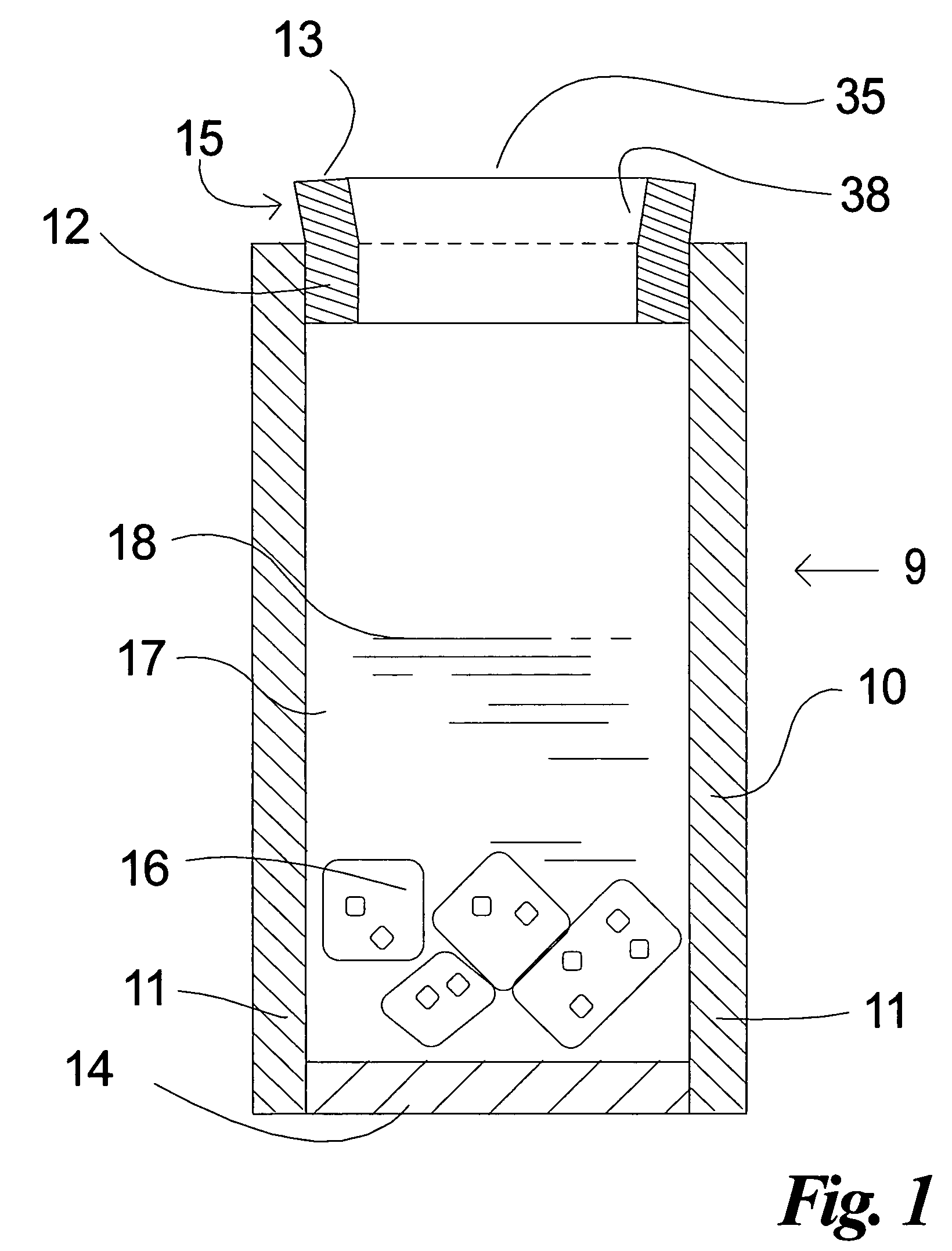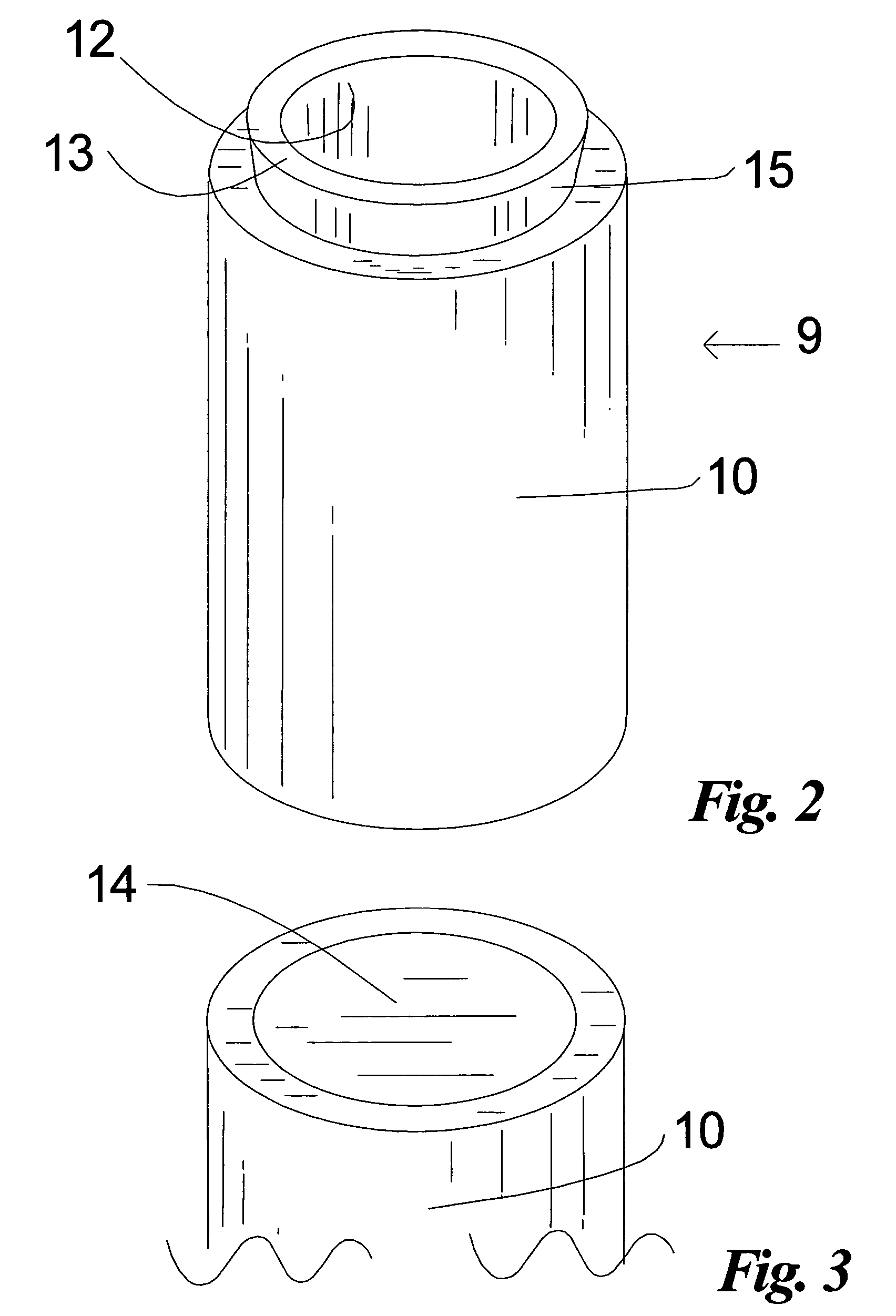Insulated single beverage container cooler/holder
a beverage container and cooler technology, applied in the field of beverage coolers, can solve the problems of insulating but not providing any cooling to the beverage, insulating holders usually do not provide watertight sealing between the container and the holder, and insulators typically have seams that are not watertight, so as to facilitate the insertion of beverage containers
- Summary
- Abstract
- Description
- Claims
- Application Information
AI Technical Summary
Benefits of technology
Problems solved by technology
Method used
Image
Examples
second embodiment
[0037]Referring now to FIGS. 5 and 6, a second embodiment 19 is shown in which the same seal 12 is concentrically positioned near the top opening of the housing 10 slightly below the top plane of housing 10. The remaining structural features of this second embodiment can be the same as that disclosed above in connection with FIGS. 1-4. As in that first embodiment, the overall dimensions (width, inside diameter, outside diameter and thickness) of the seal 12 impact the water tightness of the seal. These dimensional aspects will be further described farther below. For this embodiment, the outside diameter of the seal 12 should be equal to or slightly greater than the inside diameter of the housing. The seal should be sufficiently thick (e.g., ¼″ to ⅜″) and it should have an inside diameter slightly smaller than the outside diameter of the beverage container 22 such that the compression of the seal 12 against the container results in a watertight seal. This prevents the ice and water m...
third embodiment
[0038]The remaining embodiments each utilize certain components in common with the first embodiment of FIGS. 1-4 and like elements utilize the same reference numerals except being offset by 100, 200, etc.
[0039]Turning now to FIGS. 7-10, there is shown a third embodiment 100 in which the seal 112 comprises a two-part seal having a lower sealing portion 132 and an upper insertion portion 134. In this embodiment, the sealing portion 132 and insertion portion 134 are separate components secured directly together and / or each to the sleeve 111 in close abutting contact with each other.
[0040]The insertion portion 134 is in the shape of a wide ring sized to fit within the housing while extending above the opening of the housing. It is constructed of a stretchable / elastic, resiliently compressible and flexible closed cell foam rubber material and its characteristics impact the effectiveness of the insertion portion 134. For both the seal 12 of the first two embodiments and the insertion port...
fourth embodiment
[0070]Referring now to FIG. 11, a fourth embodiment 200 is shown. The seal 412 used in this embodiment comprises a one-piece seal formed from an insertion portion 244 that is unitary with the lower, sealing portion 242. This construction is similar to that of the third embodiment, except that in the third embodiment, the radially inward surface of the insertion portion 134 was nylon laminated neoprene and the sealing portion 132 was unlaminated neoprene, whereas in this embodiment 200, the radially inward facing side 248 of insertion portion 244 (above the imaginary line 247) does not have a nylon fabric laminate but is smooth neoprene unlaminated to improve the watertight seal of seal 212. Thus, the entire inner surface of the seal 212 (both the sealing portion 242 and insertion portion 244) is unlaminated neoprene.
PUM
 Login to View More
Login to View More Abstract
Description
Claims
Application Information
 Login to View More
Login to View More - R&D
- Intellectual Property
- Life Sciences
- Materials
- Tech Scout
- Unparalleled Data Quality
- Higher Quality Content
- 60% Fewer Hallucinations
Browse by: Latest US Patents, China's latest patents, Technical Efficacy Thesaurus, Application Domain, Technology Topic, Popular Technical Reports.
© 2025 PatSnap. All rights reserved.Legal|Privacy policy|Modern Slavery Act Transparency Statement|Sitemap|About US| Contact US: help@patsnap.com



